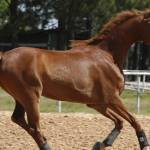Diet and Management Can Minimize Arthritic Changes in Horses

Though many people consider arthritis to be a disease of older equines, horses of any age can be affected by chronic joint inflammation. Arthritis can’t be cured, only managed, and equine professionals are realizing that diet and management can be designed in younger horses to prevent or minimize the development of arthritis as these equines mature and age.
As young horses enter training for racing or other disciplines, it’s important to progress gradually in the length and intensity of exercise periods.Joints are made up of bone, cartilage, lubricating fluid, and soft connective tissues. Developmental defects, acute damage from injuries, and gradual tissue degradation from age and use are all factors in the eventual appearance of arthritis.
In some young horses, joint cartilage does not mature properly, creating holes, flaps, and loose shreds instead of a smooth surface. Proper nutrition of the pregnant broodmare and growing foal can help to prevent some of these defects. Weighing foals and weanlings and adjusting their dietary intake to allow a smooth plane of growth are steps owners can take to avoid overloading joints as the horses grow. Keeping young horses on a frequent schedule of farrier care can also minimize strain on joints by keeping limb bones correctly aligned.
As young horses enter training for racing or other disciplines, it’s important to progress gradually in the length and intensity of exercise periods. Trainers need to be alert for signs of pain, heat, or swelling in the horse’s legs and be willing to back off the work schedule so that minor inflammation can recede. Pushing horses on in spite of these signs can greatly increase the risk of major injuries and arthritic changes in later years.
By the time horses reach five or six years old, their bones are fully mature and they are physically ready for more strenuous exercise. This doesn’t mean that they are immune to the onset of arthritis. Disciplines that involve sudden stops, sharp turns, or repeated concussion on hard ground all put the horse at a higher risk of developing joint pain and wear. Additional risks are carrying heavy loads, working long hours, becoming obese, and sustaining injuries. Because each horse is an individual, the work done by one horse might be well tolerated, while another horse on the same schedule will show signs of joint pain. To prevent arthritic changes as much as possible, riders need to watch for discomfort, give horses time off as it is needed, manage diets to keep equines at a suitable body weight, and schedule regular farrier visits.
Through their working years, some horses benefit from dietary supplements that provide various substances involved in joint health. The method of action of these supplements is not completely clear, though many horse owners swear to their efficacy. More study may explain the exact mechanism by which these substances aid in joint lubrication and support cartilage health.
Despite the best of care, many horses will still develop arthritis as they age. Because it is a progressive disease, signs tend to worsen with time. Fortunately, a number of treatments—corticosteroid administration, pain medications, and dietary supplements—can help affected horses stay comfortable, often allowing them to continue in some type of riding or driving work. Owners should consult with a veterinarian as to the best type of management for the arthritic horses in their care.








